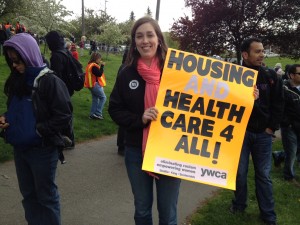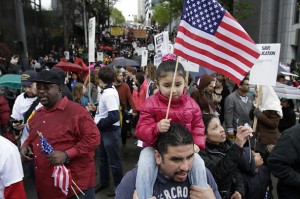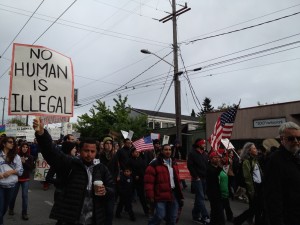Written by Devin Seman, Health Care Access Advocate at the YWCA Seattle / King / Snohomish.
On May 1, known as International Worker’s Day or May Day, events took place throughout the nation devoted to raising awareness about immigrant and worker’s rights, economic disparities, and other issues. Rallies and protests were held throughout Washington State, including Bellingham, Olympia, Seattle, and Yakima. Seattle’s protests received considerable media attention due to a group of individuals who vandalized several businesses, the courthouse, and vehicles in the downtown area. Unfortunately, this small group of individuals did not represent the larger voices of organizations such as Occupy Seattle and El Comité Pro Reforma Migratoria y Justicia Social, who sponsored May Day events in Seattle, although they received considerably more media coverage. (Riding home on the bus on May 2, I was not surprised that much of the chatter I overheard was about the violence on May Day and not about the real issues being raised.)

I attended one of these May Day events, organized by El Comité and co-sponsored by more than 40 other community and labor organizations. This peaceful protest began with a rally at Judkins Park in Seattle’s Central District and included impassioned speeches by community activists and religious leaders, as well as musical and cultural performances. Michael Ramos, Executive Director of the Church Council of Greater Seattle, spoke about how recent legislation in several states undermines the ability for immigrant families to remain unified, as new laws that make racial profiling more permissible lead to the deportation of adult family members and ultimately to the breakdown of the family unit. With low-income immigrant families becoming more financially unstable because working adult members are displaced, some find themselves entering into homelessness and starting to rely on social services, such as those the YWCA provides. Many families at the YWCA’s East Fir and East Cherry locations are immigrants and refugees, who face unique barriers in accessing safe housing, as well as educational and employment opportunities, and health services.
Before leaving Judkins Park to march downtown, one of El Comité’s leaders, Jorge Quiroga, gave participants a warning about the climate downtown, stating that “police are going to be sensitive” and recommending that protesters leave behind anything that could be construed by police as a weapon. I noticed that the atmosphere of the rally was much more subdued in years past and there were far fewer participants, partially due to the threat of violence (and also to the soggy weather).
After the rally, we started marching from St. Mary’s Church on Jackson Street toward downtown just as the rain let up. Though numbers were lower than usual, there was incredible diversity in participants: families with toddlers in strollers, religious groups, college and high school students, migrant farm workers and community organizers from the Skagit Valley, representatives from various businesses and non-profit organizations around Puget Sound, and even 84-year old Occupy activist Dorli Rainey, whose story of being pepper sprayed in the face by Seattle Police made headlines around the country back in the fall.


The atmosphere lightened up some as we marched along holding our signs high and chanting: “Si se puede” (yes we can); “Obama, escucha, estamos en la lucha” (Obama, listen, we are in the fight); “El pueblo, unido, jamás será vencido” (the people, united, will never be defeated) and other protest chants. The sign that caught my attention most strongly during the march, declaring that “No human is illegal,” was a strong reminder to me about how we speak of those who are undocumented and that we all possess an inherent human dignity, regardless of our country of origin or legal status in the United States.
When the march arrived at 4th Avenue and Columbia Street, members of Occupy Seattle and other protesters joined ranks and we had a strong showing as we marched passed Wells Fargo, one of the intended destinations, and ultimately to the Federal Building, where the march concluded.
Participating in the May Day march is always a meaningful experience for me. Gathering together with such a diverse group of people in an effort to raise awareness around human rights and immigration reform is invigorating, but I am aware that something is always lacking and something feels unfulfilled. Each year I wonder, “What comes next? What are steps that I, as a white woman who has never worried about being pulled over or detained because of my skin color, can take to support the struggles of local immigrant communities?”
This year, after joining the YWCA in September 2011, I am left questioning, “What more can I do in my work at the YWCA to make services accessible and relevant to immigrants and refugees? What more can the YWCA do to address the systemic barriers that refugee and immigrant women and families face who are struggling to get out of homelessness?” So I turn these questions over to you, “What more can we do? How do we rise to the challenge, around sensitive issues like immigration that are so politically and emotionally charged, of ending homelessness for all people, regardless of race, class, gender, sexual orientation, country of origin, or immigration status?”